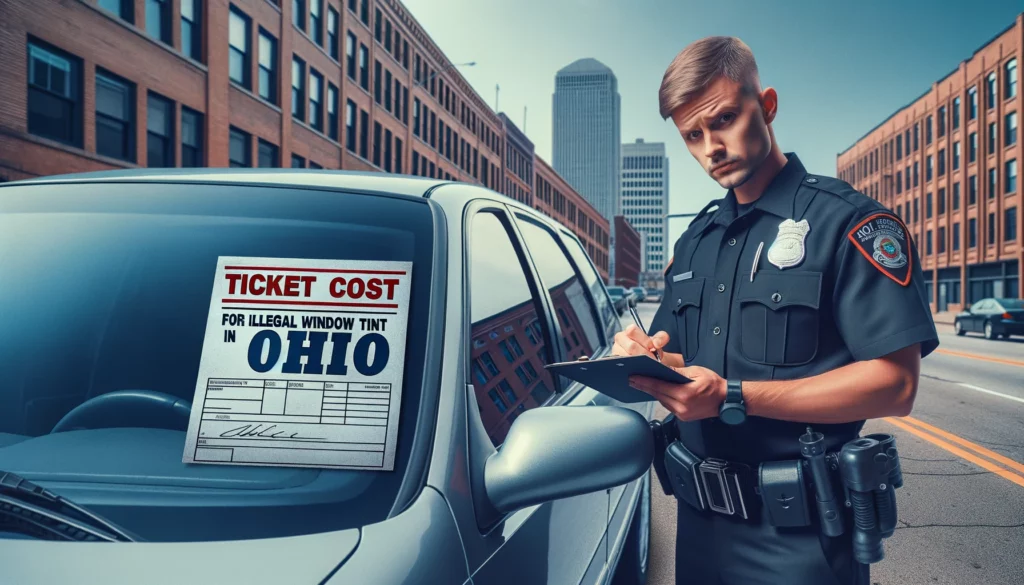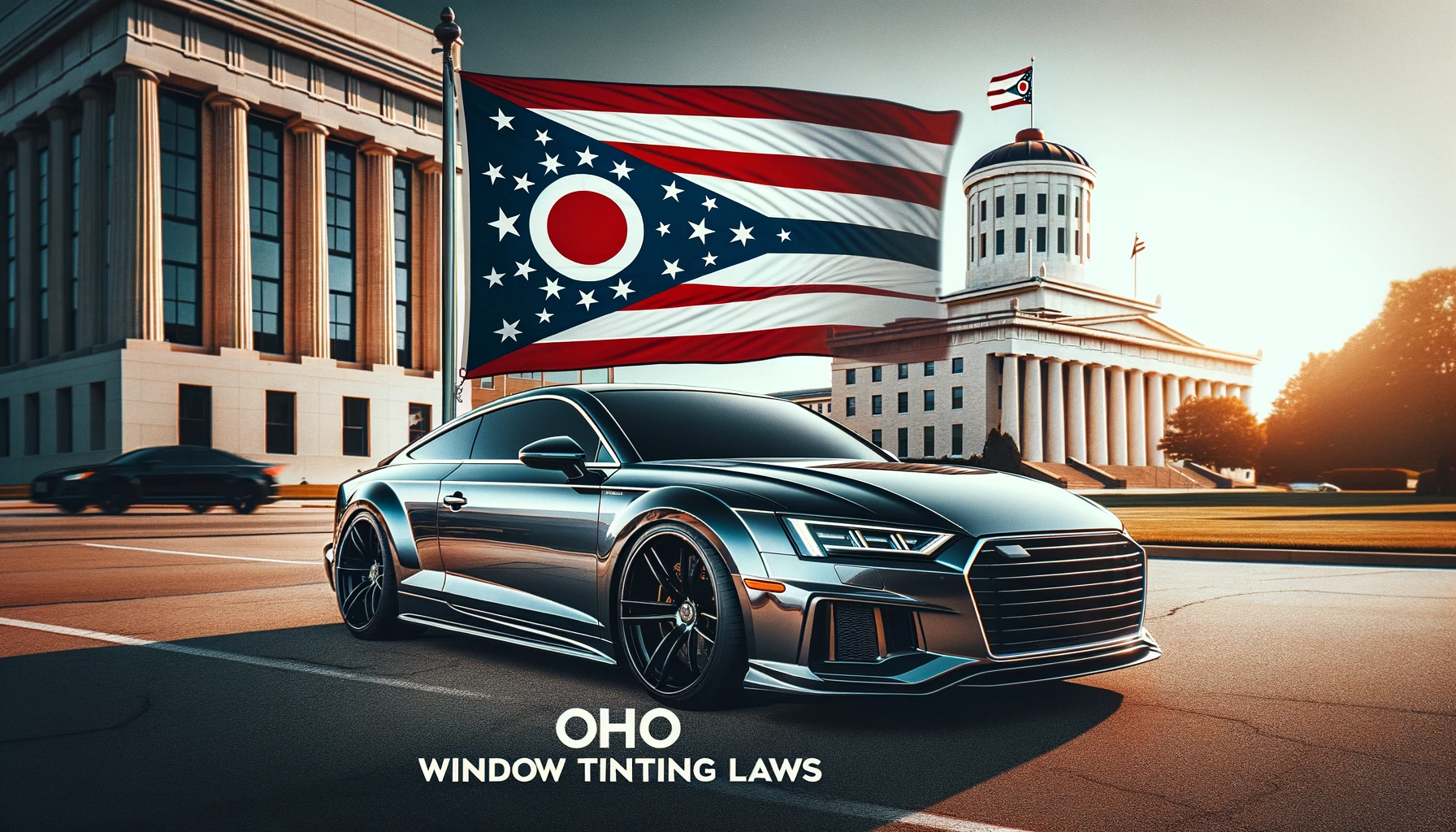Darkest legal tint for Sedans in Ohio
- Windshield: Non-reflective tint is allowed on the top 5 inches.
- Front Side windows: Must allow more than 50% of light in.
- Back Side windows: Any darkness can be used.
- Rear Window: Any darkness can be used.
Darkest legal tint for SUV and Vans in Ohio
- Windshield: Non-reflective tint is allowed on the top 5 inches.
- Front Side windows: Must allow more than 50% of light in.
- Back Side windows: Any darkness can be used.
- Rear Window: Any darkness can be used.
Ohio Tinting Regulations

Before we delve into the nitty-gritty of Ohio’s regulations, let’s address the elephant in the room: why do people tint their windows? There are several reasons:
- UV Protection: Tinted windows can block up to 99% of harmful UV rays, protecting the car’s interior and its occupants.
- Privacy and Security: Darker windows can deter potential thieves since they can’t see inside.
- Reduced Glare: Tinting can significantly reduce the sun’s glare, making driving more comfortable.
- Aesthetic Appeal: Many car owners love the sleek appearance that tinted windows offer.
Ohio’s Tinting Laws: The Breakdown
For Sedans:
- Windshield: Only non-reflective tint is allowed, and it should be on the top 5 inches.
- Front Side Windows: The tint must allow more than 50% of light to pass through.
- Back Side Windows and Rear Window: You have the freedom to choose any darkness level.
For SUVs and Vans:
- Windshield: Similar to sedans, only non-reflective tint is permitted on the top 5 inches.
- Front Side Windows: They must allow more than 50% of light in.
- Back Side Windows and Rear Window: Again, any darkness is permissible.
Reflection and Colors
Ohio’s regulations also touch on the reflectiveness of the tint and its color:
- Reflectiveness: No reflectorized materials are allowed for both sedans and SUVs/vans. This means that the tint cannot act like a mirror.
- Colors: The Buckeye State is pretty lenient here. No specific colors are banned. So, whether you’re into the classic black or a more avant-garde blue, you’re good to go.
Other Important Points to Note
- Certification: Manufacturers selling tinting film in Ohio must certify their product. If you’re getting your windows tinted, it’s a good idea to ask the dealer if they’re using certified film.
- Stickers: A sticker identifying legal tinting is required between the film and glass on each tinted window.
- Penalties: If you’re caught violating the tinting regulations, you could be looking at a misdemeanor charge and a fine of around $120.
Medical Exemptions for Ohio Tint Laws

There are several medical conditions that can make individuals more sensitive to sunlight. Some of these include:
- Lupus: People with this autoimmune disease can experience flare-ups when exposed to UV rays.
- Melanoma and Other Skin Cancers: Patients with a history of skin cancer might need to limit their UV exposure as a preventive measure.
- Photosensitivity: Certain conditions or medications can make individuals more sensitive to sunlight, causing rashes or other reactions.
For individuals with these conditions, regular window tints might not offer enough protection. Hence, the need for a medical exemption to allow darker tints.
Ohio’s Stance on Medical Exemptions
Now, here’s the crucial part: As of the last update, Ohio laws make no specific mention of medical exemptions for special tints. This means that, regardless of medical necessity, residents are expected to adhere to the standard tinting regulations.
What Can You Do?
If you or a loved one has a medical condition that necessitates darker window tints, here are some steps you can take:
- Doctor’s Note: Even though Ohio doesn’t have a formal exemption process, it’s always a good idea to have a note from your physician explaining the medical necessity. This might not prevent a ticket, but it could be useful if you need to contest a fine.
- Alternative Solutions: Consider other ways to protect yourself from the sun while in your vehicle. UV-blocking clothing, wide-brimmed hats, and sunscreens can offer added protection.
- Stay Updated: Laws and regulations can change. It’s a good idea to periodically check for updates regarding window tinting rules and medical exemptions in Ohio.
Window Film Certificates and Stickers In Ohio
At first glance, it might seem a bit bureaucratic to require certificates and stickers for something as simple as window tint. However, these regulations are in place for a reason:
- Quality Assurance: Certifying the window film ensures that it meets certain quality and safety standards. This protects consumers from subpar or potentially hazardous products.
- Law Enforcement: Stickers help law enforcement quickly identify legally tinted vehicles, streamlining traffic stops and reducing the number of unwarranted tint-related citations.
Window Film Certification in Ohio
In Ohio, manufacturers of window tinting film are required to certify their products. This means that before a particular brand or type of tinting film can be legally sold and applied in the state, the manufacturer must ensure it complies with Ohio’s regulations.
For consumers, this is beneficial. When you go to a reputable dealer to get your windows tinted, you can be confident that the film they’re using is compliant with state laws, as long as they’re using certified film.
The Role of Stickers
Once your windows are tinted, there’s another crucial component to consider: the sticker. In Ohio, a sticker that identifies legal tinting is required. This sticker should be placed between the film and the glass on each tinted window.
These stickers serve a dual purpose:
- Verification for Law Enforcement: It provides a quick way for law enforcement officers to verify that your window tint is legal without having to use a light meter.
- Assurance for Vehicle Owners: For drivers, the presence of this sticker can offer peace of mind, knowing that their tint is compliant with state regulations.
Penalties or Ticket Cost for Illegal Window Tint in Ohio

Before we jump into the costs, it’s essential to understand why these regulations exist. Ohio’s window tint laws aim to:
- Ensure Safety: Darker tints can reduce a driver’s visibility, especially at night or in low-light conditions.
- Facilitate Law Enforcement: Dark windows can make it challenging for law enforcement officers to see inside a vehicle during a traffic stop, potentially posing a safety risk.
The Price of Non-Compliance
If you’re caught with illegal window tint in Ohio, you could be looking at a misdemeanor charge. But what does that mean for your wallet?
- Ticket Cost: As of the last update, the fine for illegal window tint in Ohio is around $120. However, this amount can vary depending on the jurisdiction and the discretion of the ticketing officer.
- Additional Costs: Beyond the ticket itself, there are other potential costs to consider. You might be required to remove the illegal tint, which could mean paying for tint removal services. If you choose to retint your windows to a legal shade, that’s an additional expense.
Avoiding the Fine
The best way to avoid a ticket for illegal window tint is, of course, to ensure your tint complies with Ohio’s regulations. Here are some steps to stay on the right side of the law:
- Know the Rules: Familiarize yourself with Ohio’s window tint regulations. For most vehicles, front side windows must allow more than 50% of light in, while there’s more flexibility for back side windows and rear windows.
- Work with Reputable Dealers: If you’re getting your windows tinted, choose a reputable dealer familiar with Ohio’s regulations. They can guide you to products that are both stylish and compliant.
- Regular Checks: If you’ve had your vehicle for a while or you’ve recently purchased a used car with tinted windows, it might be worth having the tint checked to ensure it’s within legal limits
Conclusion
Tinting your vehicle’s windows in Ohio is perfectly legal, but it’s essential to be aware of the regulations. By ensuring your tint adheres to the state’s guidelines, you can enjoy the benefits of tinted windows without the worry of legal repercussions. So, next time you’re on the road in Ohio, you can ride in style, comfort, and—most importantly—within the bounds of the law.
State of Ohio Info
Ohio’s history is as diverse as its landscape. Home to ancient indigenous cultures, it later became a pivotal territory during the colonial era. The state played a significant role in the Underground Railroad, helping many enslaved individuals find freedom in the North. Fast forward to the 20th century, and Ohio was at the forefront of the industrial revolution, with cities like Cleveland and Cincinnati becoming major industrial hubs.
Geographical Wonders
Ohio boasts a diverse range of landscapes:
- Rolling Hills: The southeastern part of the state is adorned with the foothills of the Appalachian Mountains, offering breathtaking views, especially during the fall.
- Great Lakes Beauty: To the north, Ohio has a shoreline with Lake Erie, providing beautiful beaches and a vital port for trade.
- Fertile Plains: Central Ohio is characterized by its fertile plains, making it a significant agricultural hub.
Cultural and Urban Highlights
Ohio is home to several vibrant cities, each with its unique charm:
- Columbus: The state capital and the largest city, Columbus is known for its diverse communities, the Ohio State University, and a thriving arts scene.
- Cleveland: Situated on the shores of Lake Erie, it’s a city with a rich musical history, being home to the Rock and Roll Hall of Fame.
- Cincinnati: With its German heritage, Cincinnati offers a blend of historic architecture, a love for baseball, and the unique Cincinnati chili.
Economic Backbone
Ohio’s economy is as diverse as its population. Historically an industrial state, it has branched out into various sectors:
- Manufacturing: From automobiles to aircraft parts, Ohio is a manufacturing powerhouse.
- Agriculture: Ohio’s fertile lands produce soybeans, corn, dairy products, and more.
- Healthcare and Research: Cities like Cleveland are known for world-class healthcare facilities and research institutions.
A State of Festivals
Ohioans love to celebrate! From the Ohio State Fair in Columbus to the Pumpkin Show in Circleville, there’s always something happening. Music festivals, food fests, and cultural celebrations dot the calendar, reflecting the state’s diverse heritage.
Frequently Asked Questions
Is window reflection allowed for tinted windows in Ohio?
No reflectorized materials are permitted for both sedans and SUVs/vans.
Are there any color restrictions for window tints in Ohio?
No specific colors of tint are banned in Ohio.
Do manufacturers need to certify the window tint film in Ohio?
Yes, manufacturers of film need to certify the film they sell in the state. It’s recommended to ask your dealer if they are using certified film.
Are there any medical exemptions for window tinting in Ohio?
Ohio laws currently make no mention of medical exemptions for special tint.
